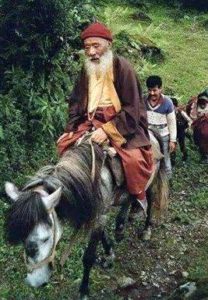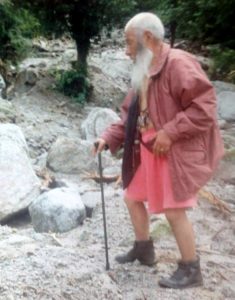Interview with Chatral Rinpoche’s daughter, Semo Saraswati
Dorje: Are you on this photo?
Semo la: No, I’m not there.
Q: I thought the one in the middle is you.
A: No, that is my sister, Tara Devi.
Q: Could you tell us, who the people are on this picture?
A: Meme Ngawang, Kathok Situ, Prince of Sikkim known as Denjong Gyalse, and other disciples like Buddha, Liece, Ongnyang, Woser Tulku, Sharibu, Tulku Pema, Rahula. It was taken in Neding. This on the right is Chatral Rinpoche and on the other side with glasses, that is Dondrupchen Rinpoche. This photo was taken during the time of the Jatsen Pedug (T. ‘Ja’ mtshon pod drug) initiation (T. dbang) in Neding.



Q: How long ago was this picture taken?
A: About 25 years ago.
Q: Dondrup Rinpoche doesn’t live in Nepal, right? Does he live in India?
A: Yes, he lives in Gangtok, Sikkim. Chatral Rinpoche requested him to come and visit. He stayed in Neding for about 15 days.
Q: Did Dondrup Rinpoche come by horse or helicopter?
A: Helicopter.
Q: Did you say, it was during Jatsen Pedug initiation?
A: Yes, during Jatsen Pedug wang (initiation).
Q: Who did give the initiation? Chatral Rinpoche?
A: No, Dondrup Rinpoche gave the wang.
Q: Oh, then who did receive the wang?
A: Everyone in the picture.
Q: Did Chatral Rinpoche received this initiation at the same time with the others?
A: Chatral Rinpoche has received it once before. There is a place called Gotsangling, where he didn’t give wang of the whole Jatsen Pedug, but he gave the wang of Jatsen Tsasum (T. ‘Ja’ mtshon rtsa gsum).
Q: What was the reason behind the invitation of Dondrubchen Rinpoche?
A: He was invited, because we follow the Longchen Ngingthig lineage, and Dondrub Rinpoche is a teacher of that lineage. Therefore, he was invited.
Q: As a layman I would think that probably Chatral Rinpoche could have given this initiation himself. Why did he take all the hardship to invite another lama?
A: Chatral Rinpoche did not give wang and lung often. Therefore, he called Dondrup Rinpoche to give the wang. Chatral Rinpoche gave wang only a few times in Gotsangling. Chatral Rinpoche did not like huge gatherings and tried to avoid big announcements for events. In Gotsangling, he gave wang for a few lamas from Gotsangling and Tarkeghyang. He never did announcements. We used to live in Drupadong, very close to Gotsangling. I was in retreat during that time in Drupadong. Chatral Rinpoche went there to give wang to 10-15 lamas.
Q: You didn’t go there?
A: No, I didn’t go. I was doing that time my three year retreat.
Q: You said, that Dondrupchen Rinpoche came and stayed in Neding for 10-15 days. Chatral Rinpoche must have been very happy.
A: Chatral Rinpoche told us, he was very happy. For Chatral Rinpoche’s request, Dondrupchen Rinpoche gave the wang of Nyingthig Tsasum (T. sNying thig rtsa gsum) at Chumig Changchub (T. Chu mig byang chub). When we were young, Dondrup Rinpoche was invited to give Nyingthig wang in Yangleshö, too.
Q: From the photo it seems there were not many people there.
A: True, there were not many people.
Q: Chatral Rinpoche did not prefer giving initiation for a big number of people?
A: No, he did not like that.
Q: There were many people, who wanted to become a disciple of Chatral Rinpoche. He must have givenmany different teachings. What was the essence of his teaching?
A: These days, it is in fashion to give any teaching, what people ask for. Chatral Rinpoche was not doing that, and people used to complain about it, they wanted him to do that. He did not give teachings often. Whatever the guru does, we should take it as if it was done by Guru Rinpoche. Even if he makes us work, that is his teaching. He made us stay in retreat and that was his way of teaching. Many people did not understand it and were complaining about not receiving teachings.
Q: What did he teach?
A: There is a book called Kunsang Lame Shelung (T. Kun bzang la ma’i zhal lung, Words of my Perfect Teacher written by Patrul Rinpoche, 1808-1887). That is what he used to teach. Anyone who wants to practice the Dharma, has to study the Kunsang Lame Shelung beforehand. The Kunsang Lame Shelung contains all the necessary teachings for Dharma practitioners. If one understands it, it is all good, but if not, then mind training has to be done. Training should not be done with the body, eyes, legs or ears, but with the mind. You have to integrate the teaching with your mind and see if it matches or not. Chatral Rinpoche always knew if someone follows the Dharma in a real sense, or just comes to receive teachings, goes back, and from the next day starts using mantras, advertises himself as a guru and flies to a foreign land. He did not like that. He wanted his disciples to go and do retreat in a peaceful place, and do good practice day and night, instead of doing some praiseworthy activities to create attention.
Q: I have the feeling, that he greatly benefitted those, who went to do retreat and practiced. What do you think about that?
A: He used to consider retreat as a good work. I did not hear him saying that, but in one of the books it is said, that making seven steps towards doing retreat is considered to be good luck. When you go to retreat, you do practices like ngondro (T. sngon ‘gro, “preliminary practices”), tsalung (T. rtsa rlung, “subtle energy practices”), phowa (T. pho ba, “mind transference”), gom (T. sgom, “contemplation”), but the most important thing is, that the mind integrates with the Dharma. Showing Dharma externally is worthless. He never gave an order of the practices one should do, the place one should go to, and the time one should spend in retreat. He considered the changes happening in one’s mind more important than external things.
Q: You mean, he gave more importance to the inner changes, than what people showed or projected externally?
A: When you practice Dharma, change comes. If one becomes worse, his ego is becoming bigger and becomes proud while practicing Dharma, it is a sign, that the Dharma does not integrate with his mind. If his devotion to the lama is increasing, and his compassion to all beings, if he is becoming friendly with everyone, and humble to all, these are signs, that the person is a good Dharma practitioner. It is considered to be good integration with the Dharma.
Q: Chatral Rinpoche had many disciples and was a guru of many different teachings. As his daughter, do you have any plan to continue his teaching activities?
A: Yes, we do have plans. Just before the earthquake Khenpo Ngawang Lendrup has completed the construction of a retreat center in Neding, Hyolmo, but unfortunately the earthquake destroyed it two months after its completion. But Khenpo Ngawang Lendrup quickly rebuilt it after the earthquake. We follow the Nyingthig lineage, because that is the lineage of Chatral Rinpoche, but as the Tamangs in the villages follow the Koncho Chindu lineage (T. dKon mchog spyi ‘dus) in every aspects of life from birth to death, we also have people from Ramechhap, Sindhuli and Kavre doing retreat in Neding according to the Koncho Chindu lineage. The retreat program is following the tradition of Chatral Rinpoche. Similarly, in Godawari a group completed a retreat in the 9th month of the lunar calendar and we may start from the following 9th month of the lunar calendar two retreat programs, a Nyingthig and a Koncho Chindu. Everywhere the retreat programs continue. The centers did not stop functioning after Chatral Rinpoche passed away. We are trying hard from our side to continue his activities and we will keep on trying.
Q: It seems, that Chatral Rinpoche gave special importance to Hyolmo as a place of practice. Why was that?
A: Because Hyolmo is a hidden land (T. sbas yul) concealed by Guru Rinpoche. When Chatral Rinpoche went to Hyolmo, he identified a new sacred place down from Dufu (T. Yang dag mchog kyi sgrub phug), the Tongshongfug (T. sTong shong phug).
Q: Rinpoche spent many years in Hyolmo.
A: Yes, he was living there for many years, he travelled on foot to many places including Bemthang, leaning on his walking stick, wearing a half pant and rubber boots.



Q: After living in Hyolmo for so many years, do you know, how he saw Hyolmo people and their situation?
A: Things are going well there. Many Hyolmo people went to the USA to work, but they practice the Dharma also while living there. Even if they work a lot, they always dedicate time to pray at tshechu (T. tshes bcu), they do nyungne (T. smyung gnas) and establish tshokpas (T. tshogs pa, “association”, “centre”) as well. It is also because Rinpoche lived in Hyolmo, and people have great devotion for him.
Q: Did he have any wish for Hyolmo people?
A: His wish was, that everyone would practice the Dharma not only in Hyolmo, but everywhere. Not just Dharma by name, but Dharma in a good sense, a pure Dharma. That was his wish for everyone. If he had a wish only for Hyolmo, that would have been in contradiction with the concept of bodhicitta. We need to have aspirations for the whole world. Rinpoche’s aspiration was, that people of the world may all practice the Dharma, every being may attain enlightenment, through meditation, doing ngondro, building stupas and statues, and liberating lives. It is possible to attain.
Q: Would you like to convey any message at the end? Anything you personally find important?
A: To everyone, who might read or listen to this interview, I would like to say: just saying “Kyabsuchi! Kyabsuchi!” to the Rinpoche is not enough, we have to practice what he taught us as well. Only then we can say, that we are his followers. He left his physical body, he is physically not with us anymore, but his blessings are always with us. He can never be separated from us. We have to follow what he taught us. What he told us was to practice the Dharma, do ngondro, love everyone without distinction, learn to meditate and then meditate, he taught us not to eat meat, not to kill animals, not to smoke and drink alcohol. Even if we cannot do great things, if we are able to do these simple things, that is excellent. These days people cannot stop eating meat, but if you can, it is a great support for Rinpoche.
Dorje: Thank you, Semo la, thank you for your time.
Semo Saraswati: Ok, good.
